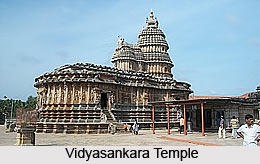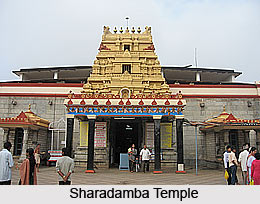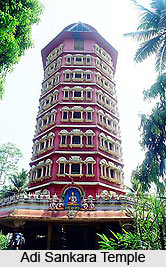 The word Sringeri is synonymous with Sri Adi Sankara, the great exponent of Advaita philosophy. The shrines of Devi Sharada and Sri Vidya Shankar are glorious and important to the Indian art and culture. The little town on the banks of Tunga River is in the midst of forests of the Western Ghats. Sringeri is renowned since Ramayana days as sage Vibandaka and his son Rishyasringa had their hermitages here. To reach this holy city the pilgrims or tourists can make use of the nearest railhead, Shimoga. From here buses, vans and cars are available to reach Sringeri. There are buses connecting Sringeri to Mangalore, Bangalore, Belur, Mysore, Hassan and Kollur.
The word Sringeri is synonymous with Sri Adi Sankara, the great exponent of Advaita philosophy. The shrines of Devi Sharada and Sri Vidya Shankar are glorious and important to the Indian art and culture. The little town on the banks of Tunga River is in the midst of forests of the Western Ghats. Sringeri is renowned since Ramayana days as sage Vibandaka and his son Rishyasringa had their hermitages here. To reach this holy city the pilgrims or tourists can make use of the nearest railhead, Shimoga. From here buses, vans and cars are available to reach Sringeri. There are buses connecting Sringeri to Mangalore, Bangalore, Belur, Mysore, Hassan and Kollur.
Sri Adi Sankara was once on a visit to this place. As he was approaching the Tunga river, the spiritual and peaceful atmosphere and nature`s harmony there impressed him. On a mid-summer noon, he witnessed a frog in labour being given shelter by a cobra, a sworn enemy, and was greatly moved. This prompted Adi Sankara to establish one of the famous Sankara Mutts and install a sandalwood image of Devi Sharada, the Goddess of Learning, in a small shrine. A stone sculpture of a snake offering hooded protection to a frog on the steps of the holy tank in Sringeri narrates this incident.
Devi Sharada Temple: The Goddess is seated on Sri Chakra Peetam holding a Japa Mala in Her upper right hand with a parrot perched on top of the hand. The lower right hand shows Chin Mudra. While the upper left hand holds the Amirtha Kalasam, the lower left hand has a book. The sandalwood image of the Goddess, installed by Adi Sankara, was replaced by a golden idol about 700 years ago by Sri Vidyaranya.
On the southern prakara, the processional deity of Devi Sharada is placed on Vyagyana Simhasana.
 Shakti Ganapati with 10 hands and Shakti on his left thigh is enshrined on the western prakara. Bhuvaneshwari, a Panchaloha image, has a shrine to the west of Devi Sharada`s sanctum. In the front mandap, the beautiful images of Rajarajeshwari and Mahishasuramardhini are eye catching. the 35 foot tall Deepa Sthamba is seen outside the Devi shrine.
Shakti Ganapati with 10 hands and Shakti on his left thigh is enshrined on the western prakara. Bhuvaneshwari, a Panchaloha image, has a shrine to the west of Devi Sharada`s sanctum. In the front mandap, the beautiful images of Rajarajeshwari and Mahishasuramardhini are eye catching. the 35 foot tall Deepa Sthamba is seen outside the Devi shrine.
A small shrine dedicated to Sri Janardhana with Sieve and Booed is located here. There are other temples here too, such as, the Brindavana of Sri Sureshwaracharya, a disciple of Adi Sankara and the first Peetathipathi of Sri Sringeri Sharada Peetam.
On Fridays and during Navaratri the image of Devi Sharada is taken round the temple in a silver ratha. Pilgrims throng to witness this and offer worship.
Adi Sankara Temple: The shrine of Sri Adi Sankara is to the left of the Sharada shrine. The image of Sri Sankara is seen on a 2 foot high peetam in Yogasana posture with a Lingam in front of him. The images of his 4 disciples are near the peetam.
In the front hall religious discourses are held regularly. These are attended by a large number of devotees. The graceful presence of the Swamiji elevates the divine and spiritual atmosphere.
Vidya Sankar Temple: This Sri Chakra-shaped shrine is a jewel on the crown of Sringeri. A sculptured treasure house, it reflects a blend of Vijayanagara, Hoysala and Dravidian temple architecture. The shrine was constructed by Bharati Krishna Theertha, a disciple of Sri Vidya Sankara Theertha, some 700 years ago. The outer wall of this temple is a specimen of great craftsmanship. In the sanctum there is a Lingam dedicated to Sri Vidya Sankara, who entered samadhi at this particular place. He had ordained his disciples to open the samadhi only at the end of 12 years when they would find an image of Chaturmurthi Vidyeswara similar to the one in Simhagiri shrine. However, they opened the samadhi before the completion of this period only to find the Lingam.
There are 12 pillars representing the 12 Rasis, their Devatas and symbols. It is amazing to note that every month, the Sun`s rays fall on a particular pillar representing that month. An idol of Saniswara is kept in oil.
 Narasimhavanam: A new bridge constructed across Tunga river leads the devotees to the abode of Sri Mahasannidhanam. Pujas are performed for Lord Chandramouleeswara. Streams of devotees gather here daily to have darshan of the Swamiji. The present Peetathipathi is Sri Bharathi Theertha Swamiji. There are also Brindavanams of the previous Peetathipathis in a marble mandap.
Narasimhavanam: A new bridge constructed across Tunga river leads the devotees to the abode of Sri Mahasannidhanam. Pujas are performed for Lord Chandramouleeswara. Streams of devotees gather here daily to have darshan of the Swamiji. The present Peetathipathi is Sri Bharathi Theertha Swamiji. There are also Brindavanams of the previous Peetathipathis in a marble mandap.
Simhagiri: A shrine dedicated to Chaturmurthi Vidyeswara is here. Vidya Theertha had ordained making of this unique sculpture with four faces. It depicts Vidya Theertha flanked by his two disciples and Brahma, Vishnu and Maheshwara on other three sides. Above them are Lakshmi Narasimha, Chandra, Surya and a Lingam on top of them all.
Malahanikareswara Temple: There is a small hillock with sage Vibandaka`s ashram on it. The shrine on the hill is dedicated to Lord Malahanikareswara.
Rishyasringapuram : This village on the banks of Nandini, a tributary of Tungabhadra, is known for a shrine dedicated to Sringeswara. It is a much respected Swayambu Lingam. Sage Rishyasringa is believed to have attained mukti here. It is 10 kilometers away from Sringeri.





















